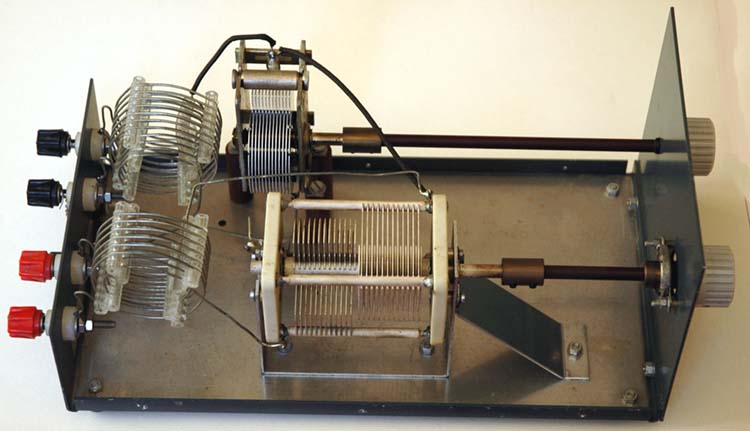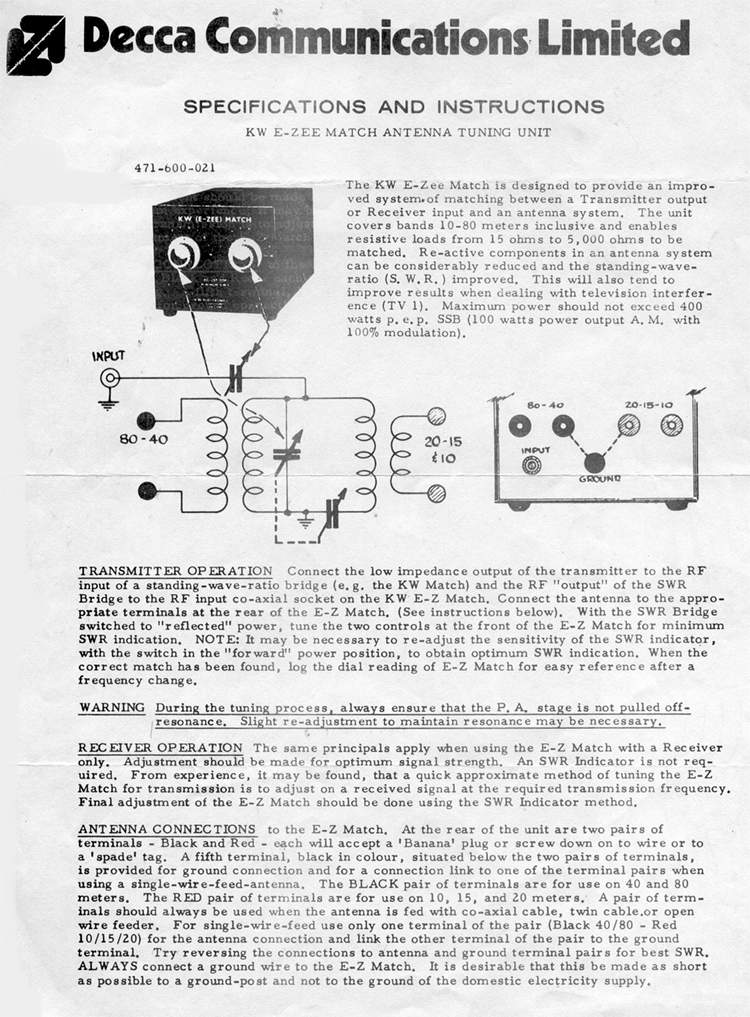|
KW EZEE MATCH
Decca
Communications KW-EZee Match antenna tuning unit.
I
Purchased the KW-EZee Match at a ham fest several years ago for about
$15 without knowing anything about it other than it appear well built
and in good condition and that it may be useful for portable
operations. Recently I dusted it off and took it into the field and
was pleasantly surprised by what is a very flexible antenna matching
unit, capable of matching a simple wire antenna or a balance feed line
antenna from 80 through to 10 metres.
This
matcher is design for what I need for portable operations, a simple
solidly built unit with no fragile switches or meters and is suited to
matching a simple wire antenna hung in a tree or similar.
The
KW-EZee Match is design for either a wire and ground connection or for
a balanced feed line without the need for the losses introduced by the
usual balun found in most modern matches.
Photo#2 shows the antenna
connections at the rear of the unit, note the centre connector of the pairs
are linked to the ground terminal, this configuration is for
unbalanced feeds such a simple wire and ground antenna or any coax
feed, if the matcher was to be used for balanced ladder line for
example the links would need to be removed.
Specifications
Frequency
Range
: 3.5 MHz – 30 MHz
Resistive
Loads: 15 ohms – 5000 ohms
Maximum
Power: 400 Watts SSB, 100 Watts AM.
Antenna
connections at the rear of the unit are two pairs of terminals each
capable of accepting banana-plugs, spade-tag or simply screw down on
to a wire.
The
black pair of terminals are primarily used for lower bands typically
80, 30 and 40 metres and the red pair of terminals are primarily used
for upper bands typically 20 through to 10 metres with a centre black
terminal below for the earth connections.
Operational
Tuning
technique
|
1/
|
Reduce
the transmitter power to the lowest practical value.
|
|
2/
|
Adjust
'C Shunt ' (Left knob) to produce a dip in the SWR
|
|
3/
|
Adjust
'C Source' (Right knob) to continue to lower the SWR.
|
|
4/
|
Retune
to step 2/ to continue to reduce the SWR. A perfect 1:1 match
should be achievable on all HF bands subject to antenna and feed
line dimensions.
|
Issues
relating to practical antenna lengths for simple wire antenna are
discussed in Long wire antenna for
portable operations.
|

|

|
|
Photo
1 Front
panel controls. Left knob is the Shunt capacitor adjustment and the Right
knob is the Source Load capacitor adjustment.
|
Photo
2 Antenna
connections at the rear of the unit are two pairs of terminals each capable
of accepting banana-plugs, spade-tag or simply screw down on to a wire.
The
black pair of terminals are primarily used for lower bands typically 80, 30
and 40 metres and the red pair of terminals are primarily used for upper
bands typically 20 through to 10 metres with a centre black terminal below
for the earth connections.
|

Photo
3
Top internal view of the KW-EZee Match unit

Photo
4
Top angled internal view of
the KW-EZee Match unit.

Schematic of the
KW-EZee Match unit.
|
L1
|
7 Turns
52mm diameter of 1.2mm2 tinned copper over the hot end of L3
|
L4
|
6 Turns
52mm diameter of 1.2mm2 tinned copper over the hot end of L3
|
|
L2
|
10 Turns
38mm diameter of 1.2mm2 tinned copper located within L1
|
C1
|
365pf
single gang variable capacitors. Plate spacing approximately
0.25mm
|
|
L3
|
7 Turns
38mm diameter of 1.2mm2 tinned copper located within L4
|
C2
|
Double gang 250pf variable capacitors. Plate spacing approximately 0.5mm
|

TOP
OF PAGE
Page initiated 01 June
2017
Page
last revised 05 November, 2025
|